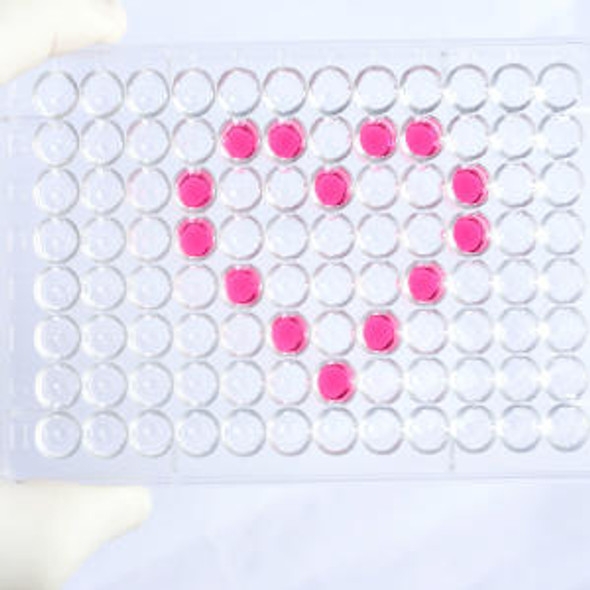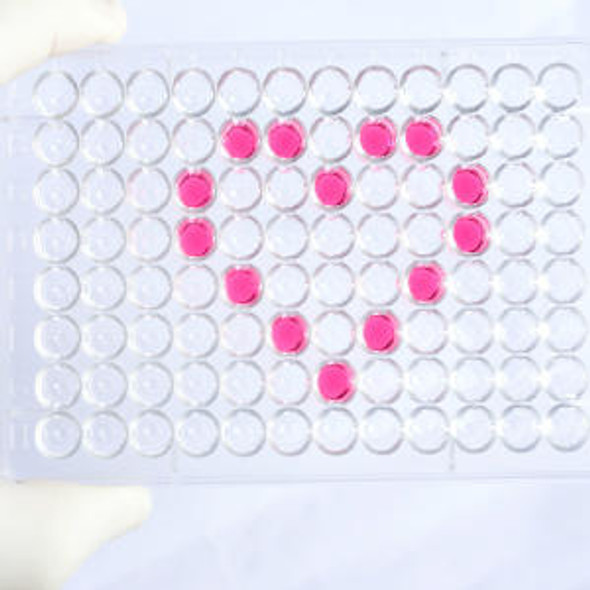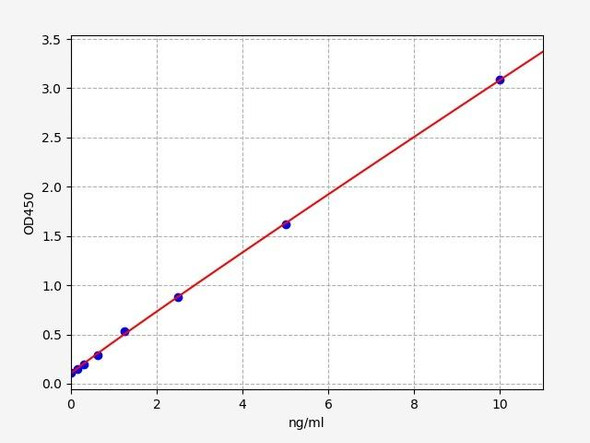Human NCAM/CD56 (Neural Cell Adhesion Molecule) ELISA Kit (HUES02842)
- SKU:
- HUES02842
- Product Type:
- ELISA Kit
- Size:
- 96 Assays
- Uniprot:
- P13591
- Sensitivity:
- 0.94ng/mL
- Range:
- 1.56-100ng/mL
- ELISA Type:
- Sandwich
- Reactivity:
- Human
- Sample Type:
- Serum, plasma and other biological fluids
- Research Area:
- Cell Biology
Description
Human NCAM/CD56 (Neural Cell Adhesion Molecule) ELISA Kit
The Human NCAM (CD56) ELISA Kit is specifically designed for the precise measurement of Neural Cell Adhesion Molecule (NCAM) levels in human samples. This kit is suitable for detecting NCAM in serum, plasma, and cell culture supernatants with high sensitivity and specificity, ensuring accurate and reliable results for various research applications.NCAM, also known as CD56, is a key protein involved in neural development and cell adhesion. It plays a significant role in processes such as neuronal migration, synaptic plasticity, and cell signaling.
Abnormalities in NCAM expression have been linked to neurological disorders, making it a valuable biomarker for studying these conditions and potential therapeutic interventions.With its advanced technology and easy-to-use format, the Human NCAM (CD56) ELISA Kit is an essential tool for researchers investigating neural development, neuronal diseases, and cell adhesion mechanisms. Invest in this kit to enhance your research capabilities and gain valuable insights into the role of NCAM in human health and disease.
| Assay type: | Sandwich |
| Format: | 96T |
| Assay time: | 4.5h |
| Reactivity: | Human |
| Detection Method: | Colormetric |
| Detection Range: | 1.56-100 ng/mL |
| Sensitivity: | 0.94 ng/mL |
| Sample Volume Required Per Well: | 100µL |
| Sample Type: | Serum, plasma and other biological fluids |
| Specificity: | This kit recognizes Human NCAM/CD56 in samples. No significant cross-reactivity or interference between Human NCAM/CD56 and analogues was observed. |
This ELISA kit uses Sandwich-ELISA as the method. The micro ELISA plate provided in this kit has been pre-coated with an antibody specific to Human NCAM/CD56. Standards or samples are added to the appropriate micro ELISA plate wells and combined with the specific antibody. Then a biotinylated detection antibody specific for Human NCAM/CD56 and Avidin-Horseradish Peroxidase (HRP) conjugate are added to each micro plate well successively and incubated. Free components are washed away. The substrate solution is added to each well. Only those wells that contain Human NCAM/CD56, biotinylated detection antibody and Avidin-HRP conjugate will appear blue in color. The enzyme-substrate reaction is terminated by adding Stop Solution and the color turns yellow. The optical density (OD) is measured spectrophotometrically at a wavelength of 450 nm ± 2 nm. The OD value is proportional to the concentration of Human NCAM/CD56. The concentration of Human NCAM/CD56 in samples can be calculated by comparing the OD of the samples to the standard curve.
| UniProt Protein Function: | NCAM1: This protein is a cell adhesion molecule involved in neuron-neuron adhesion, neurite fasciculation, outgrowth of neurites, etc. 6 isoforms of the human protein are produced by alternative splicing. |
| UniProt Protein Details: | Protein type:Membrane protein, GPI anchor; Membrane protein, integral; Cell adhesion; Motility/polarity/chemotaxis Chromosomal Location of Human Ortholog: 11q23. 1 Cellular Component: Golgi membrane; cell surface; membrane; integral to membrane; plasma membrane; external side of plasma membrane Molecular Function:identical protein binding Biological Process: axon guidance; extracellular matrix organization and biogenesis; cytokine and chemokine mediated signaling pathway; cell adhesion |
| NCBI Summary: | This gene encodes a cell adhesion protein which is a member of the immunoglobulin superfamily. The encoded protein is involved in cell-to-cell interactions as well as cell-matrix interactions during development and differentiation. The encoded protein has been shown to be involved in development of the nervous system, and for cells involved in the expansion of T cells and dendritic cells which play an important role in immune surveillance. Alternative splicing results in multiple transcript variants. [provided by RefSeq, Jun 2011] |
| UniProt Code: | P13591 |
| NCBI GenInfo Identifier: | 205830665 |
| NCBI Gene ID: | 4684 |
| NCBI Accession: | P13591. 3 |
| UniProt Related Accession: | P13591 |
| Molecular Weight: | |
| NCBI Full Name: | Neural cell adhesion molecule 1 |
| NCBI Synonym Full Names: | neural cell adhesion molecule 1 |
| NCBI Official Symbol: | NCAM1 |
| NCBI Official Synonym Symbols: | CD56; NCAM; MSK39 |
| NCBI Protein Information: | neural cell adhesion molecule 1 |
| UniProt Protein Name: | Neural cell adhesion molecule 1 |
| UniProt Synonym Protein Names: | CD_antigen: CD56 |
| UniProt Gene Name: | NCAM1 |
| UniProt Entry Name: | NCAM1_HUMAN |
As the OD values of the standard curve may vary according to the conditions of the actual assay performance (e. g. operator, pipetting technique, washing technique or temperature effects), the operator should establish a standard curve for each test. Typical standard curve and data is provided below for reference only.
| Concentration (ng/mL) | O.D | Average | Corrected |
| 100 | 2.402 2.424 | 2.413 | 2.351 |
| 50 | 1.449 1.507 | 1.478 | 1.416 |
| 25 | 0.837 0.819 | 0.828 | 0.766 |
| 12.5 | 0.463 0.475 | 0.469 | 0.407 |
| 6.25 | 0.225 0.213 | 0.219 | 0.157 |
| 3.13 | 0.167 0.147 | 0.157 | 0.095 |
| 1.56 | 0.11 0.112 | 0.111 | 0.049 |
| 0 | 0.06 0.064 | 0.062 | -- |
Precision
Intra-assay Precision (Precision within an assay): 3 samples with low, mid range and high level Human NCAM/CD56 were tested 20 times on one plate, respectively.
Inter-assay Precision (Precision between assays): 3 samples with low, mid range and high level Human NCAM/CD56 were tested on 3 different plates, 20 replicates in each plate.
| Intra-assay Precision | Inter-assay Precision | |||||
| Sample | 1 | 2 | 3 | 1 | 2 | 3 |
| n | 20 | 20 | 20 | 20 | 20 | 20 |
| Mean (ng/mL) | 4.98 | 9.49 | 34.29 | 4.65 | 8.74 | 32.25 |
| Standard deviation | 0.30 | 0.57 | 1.30 | 0.29 | 0.48 | 0.97 |
| C V (%) | 6.02 | 6.01 | 3.79 | 6.24 | 5.49 | 3.01 |
Recovery
The recovery of Human NCAM/CD56 spiked at three different levels in samples throughout the range of the assay was evaluated in various matrices.
| Sample Type | Range (%) | Average Recovery (%) |
| Serum (n=5) | 90-105 | 97 |
| EDTA plasma (n=5) | 88-101 | 95 |
| Cell culture media (n=5) | 86-99 | 93 |
Linearity
Samples were spiked with high concentrations of Human NCAM/CD56 and diluted with Reference Standard & Sample Diluent to produce samples with values within the range of the assay.
| Serum (n=5) | EDTA plasma (n=5) | Cell culture media (n=5) | ||
| 1:2 | Range (%) | 92-104 | 85-97 | 98-114 |
| Average (%) | 97 | 91 | 106 | |
| 1:4 | Range (%) | 92-106 | 86-96 | 84-94 |
| Average (%) | 97 | 91 | 89 | |
| 1:8 | Range (%) | 88-102 | 81-94 | 84-94 |
| Average (%) | 95 | 86 | 89 | |
| 1:16 | Range (%) | 94-106 | 80-92 | 87-98 |
| Average (%) | 99 | 86 | 93 |
An unopened kit can be stored at 4°C for 1 month. If the kit is not used within 1 month, store the items separately according to the following conditions once the kit is received.
| Item | Specifications | Storage |
| Micro ELISA Plate(Dismountable) | 8 wells ×12 strips | -20°C, 6 months |
| Reference Standard | 2 vials | |
| Concentrated Biotinylated Detection Ab (100×) | 1 vial, 120 µL | |
| Concentrated HRP Conjugate (100×) | 1 vial, 120 µL | -20°C(shading light), 6 months |
| Reference Standard & Sample Diluent | 1 vial, 20 mL | 4°C, 6 months |
| Biotinylated Detection Ab Diluent | 1 vial, 14 mL | |
| HRP Conjugate Diluent | 1 vial, 14 mL | |
| Concentrated Wash Buffer (25×) | 1 vial, 30 mL | |
| Substrate Reagent | 1 vial, 10 mL | 4°C(shading light) |
| Stop Solution | 1 vial, 10 mL | 4°C |
| Plate Sealer | 5 pieces | |
| Product Description | 1 copy | |
| Certificate of Analysis | 1 copy |
- Set standard, test sample and control (zero) wells on the pre-coated plate and record theirpositions. It is recommended to measure each standard and sample in duplicate. Note: addall solutions to the bottom of the plate wells while avoiding contact with the well walls. Ensuresolutions do not foam when adding to the wells.
- Aliquot 100µl of standard solutions into the standard wells.
- Add 100µl of Sample / Standard dilution buffer into the control (zero) well.
- Add 100µl of properly diluted sample (serum, plasma, tissue homogenates and otherbiological fluids) into test sample wells.
- Cover the plate with the sealer provided in the kit and incubate for 90 min at 37°C.
- Aspirate the liquid from each well, do not wash. Immediately add 100µL of BiotinylatedDetection Ab working solution to each well. Cover the plate with a plate seal and gently mix. Incubate for 1 hour at 37°C.
- Aspirate or decant the solution from the plate and add 350µL of wash buffer to each welland incubate for 1-2 minutes at room temperature. Aspirate the solution from each well andclap the plate on absorbent filter paper to dry. Repeat this process 3 times. Note: a microplatewasher can be used in this step and other wash steps.
- Add 100µL of HRP Conjugate working solution to each well. Cover with a plate seal andincubate for 30 min at 37°C.
- Aspirate or decant the solution from each well. Repeat the wash process for five times asconducted in step 7.
- Add 90µL of Substrate Reagent to each well. Cover with a new plate seal and incubate forapproximately 15 min at 37°C. Protect the plate from light. Note: the reaction time can beshortened or extended according to the actual color change, but not by more than 30min.
- Add 50 µL of Stop Solution to each well. Note: Adding the stop solution should be done inthe same order as the substrate solution.
- Determine the optical density (OD value) of each well immediately with a microplate readerset at 450 nm.






